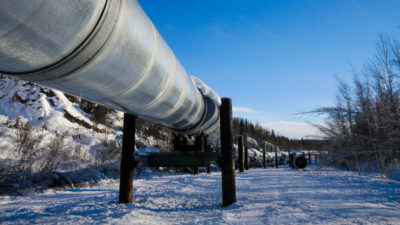Hear that? That’s the sound of money slowly draining for the coffers of the Alberta energy industry. Every day, new challenges threaten to slow or stall oil sands development. And depending on how they’re worked out, it could cost shareholders dearly. Here are the top three risks energy investors should be watching.
1. Rising natural gas prices
Oil sand companies, which have benefited from rock-bottom natural gas prices, are once again facing rising costs. Dry gas rates have doubled over the past six months thanks to an exceptionally cold winter in North America. However, prices could continue higher in the coming years as demand for natural gas perks up and liquefied natural gas exports begins to drain excess supplies.
Increasing gas prices would hit steam-powered projects the hardest. These projects use super-heated water vapour to soften bitumen deposits to the point where they can be drained and pumped to the surface. Natural gas is a necessary expense in this type of extraction method. If the prices increases by just one dollar, operating costs per barrel would jump by the same amount.
However, not all companies are exposed equally. A number of oil sand producers — namely Imperial Oil, Cenovus, and Canadian Natural Resources — have extensive natural gas operations providing a natural hedge to rising prices. However, other companies like Suncor (TSX: SU)(NYSE: SU) and Connacher Oil and Gas are the most at risk.
2. Rising shipping costs
It’s getting more expensive to ship a barrel of oil. Thanks to a combination of new pipelines, larger payouts to landowners, and more stringent regulations, the cost to move oil sands bitumen out of Alberta is rising. According to the National Energy Board, the total cost of moving oil and gas on Canadian regulated pipelines has increased 60% over the past five years.
Stepped-up regulations threaten to make this problem worse. Nowhere is this better illustrated that Enbridge’s (TSX: ENB)(NYSE: ENB) Northern Gateway proposal, where regulators only granted the pipeline’s approval if the company met a list of 209 conditions. Notably, Enbridge will have to spend an extra $500 million of extra pipe to protect against ruptures and maintain $1 billion in liability insurance to cover the clean-up costs of possible leaks.
Delays are also pushing up the cost of transporting crude. TransCanada (TSX: TRP)(NYSE: TRP) has sunk $2 billion maintaining pipe in the field for its Keystone XL pipeline while it waits for the U.S. government to approve the project. Ultimately, all of these costs will be passed on to the shippers.
3. The carbon bubble
As we burn fossil fuels, the world is getting warmer. In order to mitigate the worst effects of climate change, nations have agreed to limit global warming by two degrees centigrade.
To stay under this target, scientists estimate that global carbon emission need to remain under 500 to 900 gigatonnes through 2050. However, that’s far less than all of the world’s currently booked recoverable energy reserves. Even assuming an optimal rollout of carbon capture technology, most of the energy industry’s oil, coal, and gas reserves are essentially unburnable.
Carbon intensive assets like the oil sands are particularly sensitive to this problem. Consider Suncor’s recently approved Fort Hills mine. At current commodity prices, this project generates a 12.5% internal rate of return — probably the minimum shareholders will accept for such a risky venture. Environmental policies are also a risk. The impact of even a small tax on carbon would quickly render the play uneconomical.
Foolish bottom line
Alberta’s oil sands have overcome a lot of hurdles. Only 50 years ago, the play amounted to nothing more than a backwoods science project. Today, the oil sands are one of the most important developments in North America’s energy industry. How the industry deals with these three risk factors will be the biggest driver of shareholder returns over the next decade.







